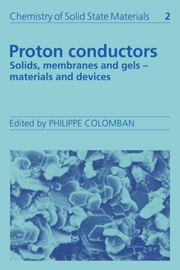Book contents
- Frontmatter
- Contents
- List of contributors
- Preface
- Symbols
- I HYDROGEN BOND AND PROTONIC SPECIES
- II MATERIALS: PREPARATION, STRUCTURES AND PROPERTIES
- 7 Structure and characterization of hydrogen insertion compounds of metal oxides
- 8 High temperature proton conductors based on perovskite-type oxides
- 9 Highly ionic hydroxides: unexpected proton conductivity in Mg(OH)2 and homologues
- 10 Ice
- 11 Anhydrous materials: oxonium perchlorate, acid phosphates, arsenates, sulphates and selenates
- 12 Hydrogen behaviour in graphite–nitric acid intercalation compounds
- 13 Proton-containing β- and β″-alumina structure type compounds
- 14 Proton conduction in zeolites
- 15 Proton containing NASICON phases
- 16 Phosphates and phosphonates of tetravalent metals as protonic conductors
- 17 Hydrogen uranyl phosphate, H3OUO4PO4. 3H2O (HUP), and related materials
- 18 From crystalline to amorphous (particle) hydrates: inorganic polymers, glasses, clays, gels and porous media
- 19 Perfluorinated membranes
- 20 Mixed inorganic-organic systems: the acid/polymer blends
- III PROTON DYNAMICS AND CHARGE TRANSPORT
- IV PROTON DIFFUSION MECHANISMS
- V DEVICES
- Index
7 - Structure and characterization of hydrogen insertion compounds of metal oxides
Published online by Cambridge University Press: 04 May 2010
- Frontmatter
- Contents
- List of contributors
- Preface
- Symbols
- I HYDROGEN BOND AND PROTONIC SPECIES
- II MATERIALS: PREPARATION, STRUCTURES AND PROPERTIES
- 7 Structure and characterization of hydrogen insertion compounds of metal oxides
- 8 High temperature proton conductors based on perovskite-type oxides
- 9 Highly ionic hydroxides: unexpected proton conductivity in Mg(OH)2 and homologues
- 10 Ice
- 11 Anhydrous materials: oxonium perchlorate, acid phosphates, arsenates, sulphates and selenates
- 12 Hydrogen behaviour in graphite–nitric acid intercalation compounds
- 13 Proton-containing β- and β″-alumina structure type compounds
- 14 Proton conduction in zeolites
- 15 Proton containing NASICON phases
- 16 Phosphates and phosphonates of tetravalent metals as protonic conductors
- 17 Hydrogen uranyl phosphate, H3OUO4PO4. 3H2O (HUP), and related materials
- 18 From crystalline to amorphous (particle) hydrates: inorganic polymers, glasses, clays, gels and porous media
- 19 Perfluorinated membranes
- 20 Mixed inorganic-organic systems: the acid/polymer blends
- III PROTON DYNAMICS AND CHARGE TRANSPORT
- IV PROTON DIFFUSION MECHANISMS
- V DEVICES
- Index
Summary
Introduction
Most transition-metal oxides are unreactive towards molecular hydrogen below elevated temperatures. However, dissociated hydrogen reacts topotactically with a wide range of binary and ternary transition-metal and uranium oxides at ambient temperature to produce hydrogen insertion compounds of formula HxMOn or HxMM′On which are often referred to as ‘hydrogen bronzes'. These compounds are, in general, non-stoichiometric, with biphasic regions containing solids of fixed composition in equilibrium, separated by single-phase regions of variable hydrogen content. Powder X-ray diffraction confirms that the lattice parameters of the parent oxide are little changed on hydrogen insertion, with the implication that the metal-oxygen framework is largely retained. (At high x values, however, amorphous products are sometimes found implying that a structural collapse has occurred.) The maximum hydrogen contents achieved under standard conditions are controlled by both structural factors and the redox characteristics of the metal oxidation states involved (Table 7.1).
The hydrogen insertion compounds HxMOn are formally mixed valence and, in marked contrast to the parent oxides, often have deep colours and behave as good electronic conductors, either metallic or semiconducting. The controllable variation in electronic properties has been exploited in electrochromic displays, which utilize the colour changes induced by insertion into e.g. WO3 or IrO2 films and in other sensors, which respond to conductivity or optical changes in oxides on hydrogen incorporation. The recovery of hydrogen on heating, HxMOn = Hx–yMOn + y/2H2 (for favourable systems at high x values), suggests a possible application as hydrogen storage materials.
- Type
- Chapter
- Information
- Proton ConductorsSolids, Membranes and Gels - Materials and Devices, pp. 101 - 121Publisher: Cambridge University PressPrint publication year: 1992
- 1
- Cited by



